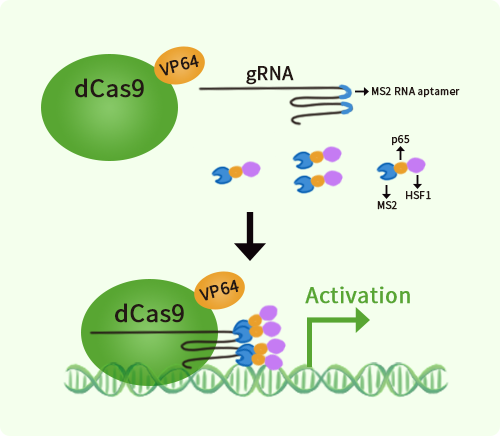Mouse Asic1 activation kit by CRISPRa
CAT#: GA200019
Asic1 CRISPRa kit - CRISPR gene activation of mouse acid-sensing (proton-gated) ion channel 1
Find the corresponding CRISPRi Inhibitor Kit
USD 1,657.00
2 Weeks*
Specifications
| Product Data | |
| Format | 3 gRNAs (5ug each), 1 scramble ctrl (10ug) and 1 enhancer vector (10ug) |
| Symbol | Asic1 |
| Locus ID | 11419 |
| Kit Components | GA200019G1, Asic1 gRNA vector 1 in pCas-Guide-GFP-CRISPRa GA200019G2, Asic1 gRNA vector 2 in pCas-Guide-GFP-CRISPRa GA200019G3, Asic1 gRNA vector 3 in pCas-Guide-GFP-CRISPRa 1 CRISPRa-Enhancer vector, SKU GE100056 1 CRISPRa scramble vector, SKU GE100077 |
| Disclaimer | These products are manufactured and supplied by OriGene under license from ERS. The kit is designed based on the best knowledge of CRISPRa SAM technology. The efficiency of the activation can be affected by many factors, including nucleosome occupancy status, chromatin structure and the gene expression level of the target, etc. |
| Reference Data | |
| RefSeq | NM_001289791, NM_009597 |
| UniProt ID | Q6NXK8 |
| Synonyms | Accn2; AI843610; ASIC; ASIC1a; B530003N02Rik; BNaC2 |
| Summary | Proton-gated sodium channel; it is activated by a drop of the extracellular pH and then becomes rapidly desensitized. Generates a biphasic current with a fast inactivating and a slow sustained phase. Has high selectivity for sodium ions and can also transport lithium ions with high efficiency. Can also transport potassium ions, but with lower efficiency. It is nearly impermeable to the larger rubidium and cesium ions. Mediates glutamate-independent Ca(2+) entry into neurons upon acidosis. This Ca(2+) overloading is toxic for cortical neurons and may be in part responsible for ischemic brain injury. Heteromeric channel assembly seems to modulate channel properties. Functions as a postsynaptic proton receptor that influences intracellular Ca(2+) concentration and calmodulin-dependent protein kinase II phosphorylation and thereby the density of dendritic spines. Modulates activity in the circuits underlying innate fear.[UniProtKB/Swiss-Prot Function] |
Documents
| Product Manuals |
| FAQs |
| SDS |
Resources
Other Versions
| SKU | Description | Size | Price |
|---|---|---|---|
| KN501678 | Asic1 - KN2.0, Mouse gene knockout kit via CRISPR, non-homology mediated. |
USD 1,657.00 |
{0} Product Review(s)
Be the first one to submit a review






























































































































































































































































 Germany
Germany
 Japan
Japan
 United Kingdom
United Kingdom
 China
China
